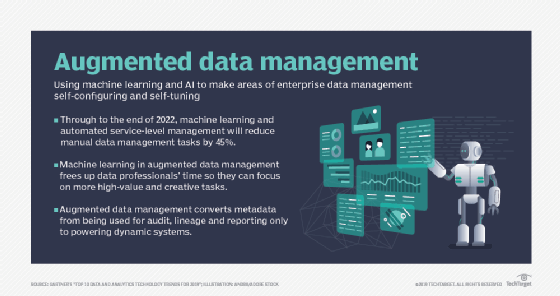
sdecoret - stock.adobe.com
Machine learning bots enable immediate paperless workplaces
Document digitization allows for the automatic extraction of data through rapid bot technology, as companies aim for a cost-effective, eco-friendly paperless workplace.
Enterprises are digitizing printed records in order to save physical space and money while increasing data mining opportunities and boosting compliance efforts. The goal is to get to a truly paperless workplace.
These businesses are removing unstructured paper records from their storage units and physical warehouses, digitizing the records and structuring the newly digital data for usability and easier electronic document management. Automated AI -- which aims to digitize paper records by scanning, sorting, structuring and labeling millions of records without human assistance -- is playing an important role in this process.
Print is out, machine learning is in
The use of machine learning bots and AI-powered paper digitization means that businesses can do more than simply scan and store files. They can create highly structured digital data that can itself feed machine learning algorithms that improve or inform business processes.
"Machine learning and other AI technologies in business operations go far beyond mere cost savings," said Ashok Pai, vice president and head of cognitive business operations at Tata Consultancy Services. "Superior business outcomes, business growth, agility, enriched customer experience are a direct impact of adopting cognitive technologies."
Ripcord Inc., a file digitization company based in Hayward, Calif., is one vendor whose tools assist enterprises in their digitization of paper records. The company uses machine learning bots to scan records, extract data, and send everything to the cloud before recycling the paper records. The ultimate goal of this process is to create data, since machine learning and robotic process automation (RPA) utilize company data to process transactions, manipulate data, trigger responses and communicate with other systems. Feeding these systems with high-quality, structured data is a top priority for many businesses.
How a paperless workplace can work
Paper records can complicate these processes by making some data inaccessible to bots, or requiring humans to do manual data entry, an error-prone process. Customers with existing RPA implementations or other data-powered applications need to acquire data that is stripped of personally identifiable information and potential inaccuracies or biases.
For Ripcord customers, after their paper records are digitized, they receive their content back in the form of machine-readable data. They can then upload their data to a third-party database or their own platforms, such as Oracle or Salesforce. The records are searchable in the cloud. For some enterprises, the data goes directly into existing machine learning or AI platforms.
What enterprises do with the data can range from implementing algorithms to identify pain points, to creating an automated process, to augmenting human workers. Pai said that in order for paper digitization to deliver its maximum benefits, companies have to take a holistic view of their processes and identify which data – and how much – is necessary to affect change.
"AI has to learn from data and decisions," he said. "Do you have the right data history that can be leveraged? If not, are you willing to invest for the long run as AI learns? Which organization sub-units are best set up to consume resources on the cloud?"

Enterprises in oil and gas industries, where paperless records and digitization are key to corporate growth, are already seeing growth from paper digitization. With billions of dollars invested in predictive analytics, data extraction and organization helps mining industries to better map mining opportunities.
Moving to a paperless workplace can cut out human involvement in these types of processes, which can help reduce the risk of error and wasted time and money -- but it can also risk compliance issues if not done correctly.
PII, GDPR and other acronyms
The evolution of data privacy and protection rules has placed a premium on data stores that are organized and controlled, but automation doesn't always mean increased safety.
A digital workplace introduces risk by taking humans out of processes and introducing a lack of transparency and predictability when AI and analytics make decisions, said Forrester analyst Craig Le Clair.
Here, transparency doesn't simply mean being able to explain the process of digitization, but means analyzing data output for biases, especially if digitization of records is a step to creating data sets that are used in further algorithms used to make business decisions.
If done right, with accountability and transparency in digitization and data output, the journey to a paperless workplace can actually decrease and mitigate risk.
"The use of artificial intelligence to manage risk is particularly helpful when handling and evaluating unstructured data," Pai said.
Over half of the content Ripcord receives has personally identifiable information (PII), which can complicate compliance with evolving data privacy regulations. Machine learning-enabled robots that scan documents, extract and organize data, need to then structure the data for compliance including redacting private names and details before the original document is shredded and recycled.
"[The European Union's] General Data Protection Regulation (GDPR) and California Consumer Privacy Act (CCPA) have changed the way that we view the content and changed the way we share with our customer," said Alex Fielding, CEO of Ripcord Inc.
Some companies prefer minimal eyes on private information while others opt for human redaction and organization of their content with PII. Other companies simply want the data, and don't need to access the redacted forms at all and would prefer automated organization. The journey to a paperless workplace, especially when outsourced, has to be compliant with a variety of privacy regulations that are industry-specific, from HIPAA in healthcare to TREAD in vehicle manufacturing.








